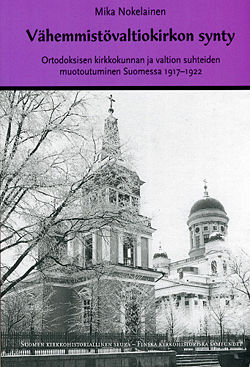The Birth of the Minority State Church Development (dissertation)
Ortodoksi.netista
The Birth of the Minority State Church Development of the legal relationship between the state of Finland and the Finnish Orthodox Church 1917-1922
Public examination of a doctoral dissertation in the field of Skandinavian and Finnish Church history
Doctoral candidate: Mika Nokelainen
Date and venue: 11.6.2010, University of Helsinki, Helsinki
The Birth of the Minority State Church Development of the legal relationship between the state of Finland and the Finnish Orthodox Church 1917-1922. Mika Nokelainen, University of Helsinki, Finland.
The present research seeks to explain how the legal relationship developed between the state of Finland and the Orthodox Church of Finland. The main focus is on three statutes:
- the Statute of the Orthodox Church in Finland as stated by Prime Minister J. K. Paasikivi s cabinet in November 1918,
- The Republican Constitution of July 1919 and
- The Freedom of Religion Act of 1923.
This study examines how different political goals influenced the three statutes mentioned above. Another important factor that is taken into account is the attitude of the Lutheran Church of Finland, the church of the national majority, towards the Orthodox minority and its judicial position in the country. Finland became independent in December 1917, in the aftermath of the November Revolution in Russia. The Orthodox Church already had hundreds of years of history in Finland. In the 19th century, several statutes by emperors of Russia had made the Orthodox Church an official state church of Finland. Due to the long history of the Orthodox Church in Finland, Prime Minister Paasikivi s cabinet made the decision to support the church in the spring of 1918. Furthermore, the cabinet s goal to occupy East Karelia increased its willingness to support the church. The Finnish-national Orthodox Church was needed to educate the East-Karelians. A new statute on the Orthodox Church in Finland came into force in November 1918, reorganising the administration, economy and legal relationship between the church and state in Finland. With this statue, the cabinet gained some authority over the church. Sections of this statute made possible, for example, the cabinet s interference in the internal affairs of the church. The Republican Constitution of 1919 included the principle of freedom of religion. The state, which previously had been Lutheran, now became non-denominational. However, the Republican Constitution explicitly mentioned the Lutheran as well as the Orthodox Church, which indirectly confirmed the position of the Orthodox Church as the second state church of Finland. This position was finally confirmed by the Freedom of Religion Act in 1923. In general, the Lutheran Church of Finland did not resist the judicial position of the Orthodox Church. However, some Lutherans regarded the Orthodox Church with suspicion because of its intimate connection with Russia.
-> (In Finnisch)
